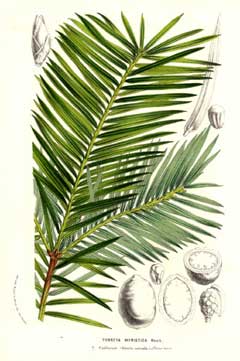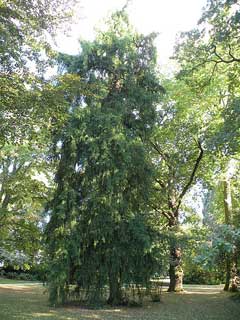 |
|
commons.wikimedia.org/wiki/File:Torreya_californica_-_Lemaire.jpg |
 |
| commons.wikimedia.org/wiki/User:Pymouss |
Translate this page:
Summary
Physical Characteristics

 Torreya californica is an evergreen Tree growing to 15 m (49ft) by 8 m (26ft) at a slow rate.
Torreya californica is an evergreen Tree growing to 15 m (49ft) by 8 m (26ft) at a slow rate.
See above for USDA hardiness. It is hardy to UK zone 7. It is in leaf all year, in flower in May, and the seeds ripen from September to November. The species is dioecious (individual flowers are either male or female, but only one sex is to be found on any one plant so both male and female plants must be grown if seed is required). and is pollinated by Wind. The plant is not self-fertile.
Suitable for: light (sandy), medium (loamy) and heavy (clay) soils. Suitable pH: mildly acid, neutral and basic (mildly alkaline) soils and can grow in very acid and very alkaline soils.
It can grow in full shade (deep woodland) semi-shade (light woodland) or no shade. It prefers moist soil.
UK Hardiness Map
US Hardiness Map
Synonyms
T. myristica. Tumion californicum.
Plant Habitats
Woodland Garden Canopy; Secondary; Sunny Edge; Dappled Shade; Shady Edge; not Deep Shade;
Edible Uses
Edible Parts: Oil Seed
Edible Uses: Oil
Seed - raw or cooked[183]. The seeds are roasted and eaten[257]. They are rich in oil[105, 161]. The ovoid seed is up to 2cm long[K]. An edible oil is obtained from the seed[177, 183].
References More on Edible Uses
Medicinal Uses
Plants For A Future can not take any responsibility for any adverse effects from the use of plants. Always seek advice from a professional before using a plant medicinally.
Analgesic Diaphoretic Febrifuge Stomachic TB
The nuts have been chewed as a treatment for indigestion[257]. A decoction of the nuts has been used in the treatment of tuberculosis[257]. The crushed seeds have been rubbed on the temples in the treatment of headaches[257]. They have also been rubbed on the body to cause sweating in the treatment of chills and fevers[257].
References More on Medicinal Uses
The Bookshop: Edible Plant Books
Our Latest books on Perennial Plants For Food Forests and Permaculture Gardens in paperback or digital formats.

Edible Tropical Plants
Food Forest Plants for Hotter Conditions: 250+ Plants For Tropical Food Forests & Permaculture Gardens.
More

Edible Temperate Plants
Plants for Your Food Forest: 500 Plants for Temperate Food Forests & Permaculture Gardens.
More

More Books
PFAF have eight books available in paperback and digital formats. Browse the shop for more information.
Shop Now
Other Uses
Basketry Oil Wood
The roots have been used as splints in basketry[257]. Wood - straight-grained, strong, light, soft, easily worked. Of no commercial value[229], though it is occasionally used for fence posts[82, 229].
Special Uses
Scented Plants
References More on Other Uses
Cultivation details
Succeeds in ordinary garden soil, tolerating some lime[1]. Undemanding as to the soil pH[200]. Dislikes wind exposure[200]. Requires a sheltered position and either high humidity or a moist riverside soil[200]. Tolerates woodland shade very well[200]. One report says that trees are only hardy in the milder parts of Britain[1], whilst another says that trees are hardy in Britain at least as far north as Edinburgh[200]. This species is the only member of the genus that is fully adapted to cool maritime sites. It can actually grow faster in such a position than it does in the wild[200]. Trees in general grow better in the wetter western part of Britain[81]. Usually slow growing, though trees occasionally increase by 60cm in a year[185]. The bruised leaves release a powerful resinous smell[245]. The fruits are also aromatic[245]. The seed takes two summers to mature[229]. Trees often crop well at Kew, but there were no seeds formed in 1994[K]. A tree in fairly deep shade at Kew was carrying a good crop of seeds in the summer of 1996[K]. Plants are usually dioecious, but isolated female plants have been known to bear fruit in the absence of a pollinating male[11]. Plants are sometimes monoecious with dioecious branches. Male and female plants must usually be grown if seed is required.
References Carbon Farming Information and Carbon Sequestration Information
Temperature Converter
Type a value in the Celsius field to convert the value to Fahrenheit:
Fahrenheit:
The PFAF Bookshop
Plants For A Future have a number of books available in paperback and digital form. Book titles include Edible Plants, Edible Perennials, Edible Trees,Edible Shrubs, Woodland Gardening, and Temperate Food Forest Plants. Our new book is Food Forest Plants For Hotter Conditions (Tropical and Sub-Tropical).
Shop Now
Plant Propagation
Seed - best sown as soon as it is ripe in a cold frame. Some of the seed should germinate in the following spring though much of it might take another 12 months. Stored seed requires a period of cold stratification and can take 18 months or more to germinate. Prick out the seedlings into individual pots as soon as growth is observed and grow them on in light shade in the greenhouse for at least the next couple of winters, making sure to pot them on into larger pots as and when required. Plant them out into their permanent positions in early summer when the plants are at least 20cm tall. Cuttings of half-ripe shoots in late summer[1]. Cuttings do not grow well[11]. Layering.
Other Names
If available other names are mentioned here
Native Range
NORTHERN AMERICA: United States (California)
Weed Potential
Right plant wrong place. We are currently updating this section.
Please note that a plant may be invasive in one area but may not in your area so it's worth checking.
Conservation Status
IUCN Red List of Threatened Plants Status :

Growth: S = slow M = medium F = fast. Soil: L = light (sandy) M = medium H = heavy (clay). pH: A = acid N = neutral B = basic (alkaline). Shade: F = full shade S = semi-shade N = no shade. Moisture: D = dry M = Moist We = wet Wa = water.
Now available:
Food Forest Plants for Mediterranean Conditions
350+ Perennial Plants For Mediterranean and Drier Food Forests and Permaculture Gardens.
[Paperback and eBook]
This is the third in Plants For A Future's series of plant guides for food forests tailored to
specific climate zones. Following volumes on temperate and tropical ecosystems, this book focuses
on species suited to Mediterranean conditions—regions with hot, dry summers and cool, wet winters,
often facing the added challenge of climate change.
Read More
Expert comment
Author
Torr.
Botanical References
11200270
Links / References
For a list of references used on this page please go here
Readers comment
| Add a comment |
|
If you have important information about this plant that may help other users please add a comment or link below. Only comments or links that are felt to be directly relevant to a plant will be included. If you think a comment/link or information contained on this page is inaccurate or misleading we would welcome your feedback at [email protected]. If you have questions about a plant please use the Forum on this website as we do not have the resources to answer questions ourselves.
* Please note: the comments by website users are not necessarily those held by PFAF and may give misleading or inaccurate information.
To leave a comment please Register or login here All comments need to be approved so will not appear immediately.
|
Subject : Torreya californica
|
|
|
|